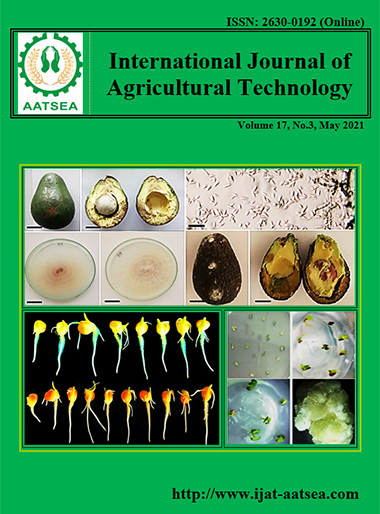Effect of osmopriming and coating seed with captan and metalaxyl on the germination and seedling growth of field corn
Main Article Content
Abstract
Priming of corn seeds with 0.4 g of KNO3 did not affect germination percentage and speed of germination. On the contrary, it promotes better shoot length, root length and total seedling length than other methods. Priming with 0.4 g of KNO3 followed by any coating methods, with or without fungicide, did not affect germination percentage and speed of germination but resulted in higher shoot length when tested under laboratory condition. However, the same seed treatments under the greenhouse condition, though did not affect germination percentage and speed of germination, but resulted in higher coleoptile emergence percentage when compared to control. In addition, coating corn seeds with 0.5 g.ai. of metalaxyl gave rise to the highest shoot length. Therefore, corn seed treatments which involved priming with 0.4 g of KNO3 followed by coating with 0.5 g.ai. of metalaxyl was the most suitable for field corn
Article Details

This work is licensed under a Creative Commons Attribution-NonCommercial-NoDerivatives 4.0 International License.
References
Agricultural Research Development Agency (2016). Field corn, soybean, green bean, and peanut, direction of Thai economic crops in ASEAN. Pornsup Printing Co., Ltd., Bangkok, Thailand.
Barker, A. V. and Pilbeam, D. J. (2007). Handbook of plant nutrition. Taylor & Francis, Boca Raton.
Bradford, K. J., Steiner, J. J. and Trawatha, S. E. (1990). Seed priming influence and emergence of pepper seed lots. Crop Science Journal, 30:718-721.
Bunnag, S. (1999). Introduction to plant physiology. Department of Biology, Faculty of Science, Khon Kaen University, Thailand. Copeland, L. E. and McDonald, M. B. (1995). Seed science and technology. Champ & Hall, New York.
Ek-Amnuay, P. (2007). Plant diseases and insect pests of economic crops. Amarin Printing & Publishing Public Company Limited, Bangkok, Thailand.
Flexer, J. and Belnavis, D. (2000). Microbial insecticides. In Rechcigl, J. E. and Rechcigl, N. A. (Eds.). Biological and biotechnological control of insect pest. Lewis Publishers, Florida, USA, pp.35-62.
Inglis, G. D., Goettel, M. S., Butt, T. M. and Strasser, H. (2006). Use of hyphomycetous fungi for managing insect pests. In Butt, T. M., Janckson, C. and Magan, N. (Eds.). Fungi as biocontrol agents progress, problems and potential. CABI Publishing, London, UK, pp.23-70.
ISTA (2013). International rules for seed testing. ISTA, Bassersdorf.
Kaewnaree, P., Vichitphan, S., Vichitphan, K., Siri, B. and Klanrit, P. (2011). Effect of accelerate aging process on seed quality and biochemical changes in sweet pepper (Capsicum annuum Linn.) seeds. Biotechnology, 10:175-182.
Krainart, C., Siri, B. and Vichitphan, K. (2015). Effects of accelerated aging and subsequent priming quality and biochemical change of hybrid cucumber (Cucumis sativa Linn.) seeds. Journal of Agricultural Technology, 11:165-179.
McDonald, M. B. (2000). Seed priming. In Black, M. and Bewley, J. D. (Eds.). Seed technology and its biological basis. Sheffield Academic Press, Sheffield, England, pp.287-325.
Pedrini, S., Merritt, D. J., Stevens, J. and Dixon, K. (2017). Seed coating: science or marketing spin?. Trends in Plant Science, 22:106-116.
Pedrini, S., Bhalsing, K., Cross, A. T. and Dixon, K. W. (2018). Protocol development tool (PDT) for seed encrusting and pelleting. Seed Science and Technology, 46:393-405.
Taylor, A. G., Allen, P. S., Bennett, M. A., Bradford, K. J., Burris, J. S. and Misra, M. K. (1998). Seed enhancements. Seed Science Research, 8:245-256.
Theerakulpisut, P. (1997). Plant physiology. Department of Biology, Faculty of Science, Khon Kaen University, Thailand.
Van Iersel, M. W. and Bugbee, B. (1996). Phytotoxic effects of fungicides on bedding plants. Journal of the American Society for Horticultural Science, 121:1095-1102.


